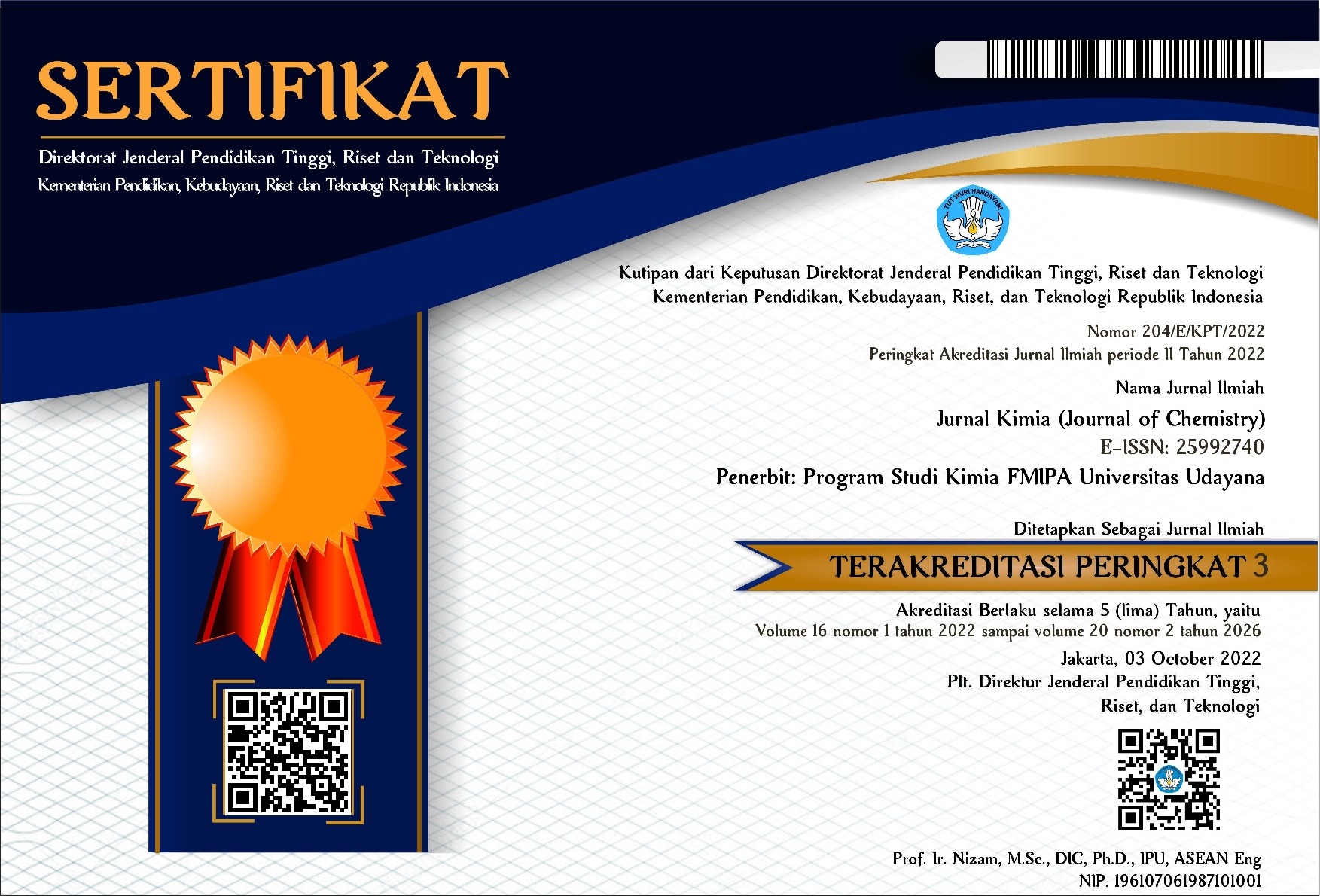ADSORPSI ION LOGAM Cu(II) DAN Cr(III) OLEH BIOSORBEN BATANG TANAMAN GUMITIR TERAKTIVASI ZnCl2
Abstract
Ion logam Cu(II) dan Cr(III) sering dijumpai dalam limbah sebagai akibat kegiatan industri. Adsorpsi adalah salah satu metode untuk mengurangi konsentrasi logam berat di perairan. Batang tanaman gumitir merupakan suatu biomassa limbah organik yang dapat dijadikan sebagai bahan biosorben. Penelitian ini bertujuan untuk mengetahui isotherm adsorpsi, kinetika adsorpsi, dan kapasitas adsorpsi biosorben batang gumitir yang diaktivasi dengan ZnCl2 pada adsorpsi Cu(II) dan Cr(III). Penelitian ini meliputi penentuan perbandingan massa antara biosorben dan ZnCl2 yang menghasilkan biosorben teraktivasi dengan kapasitas adsorpsi yang optimum, penentuan keasaman permukaan, luas permukaan, waktu kontak optimum, penentuan isoterm adsorpsi, kinetika adsorpsi, serta kapasitas adsorpsi batang gumitir terhadap logam Cu dan Cr dalam larutan. Biosorben batang gumitir teraktivasi ZnCl2 dengan kapasitas adsorpsi optimum selanjutnya dikarakterisasi dengan FTIR untuk mengetahui gugus fungsinya. Hasil penelitian menunjukkan bahwa perbandingan massa antara biosorben dan aktivator ZnCl2 untuk adsorpsi kedua logam yang optimum yaitu 1:1,25. Adsorben ini memiliki keasaman permukaan 1,7613 ± 0,0324 mmol/g dengan jumlah situs aktif sebesar 1,0609 × 1021 ± 0,0195 molekul/g. Aktivasi mampu memperbesar luas permukaan dari 1,0082 ± 0,0204 m2/g tanpa aktiasi menjadi 4,1203 ± 1,1560 m2/g dengan aktivasi. Hasil FTIR menunjukkan bahwa batang gumitir teraktivasi ZnCl2 mengandung gugus hidroksil (O?H), C?H, dan karbonil (C=O). Adsorpsi optimum untuk kedua ion logam dicapai dengan waktu kontak 60 menit. Adsorpsi ion logam Cu(II) dan Cr(III) oleh batang gumitir teraktivasi ZnCl2 mengikuti pola isoterm Freundlich, dan model kinetika adsorpsi terhadap logam Cu cenderung mengikuti model kinetika orde satu, sedangkan logam Cr tidak mengikuti model kinetika orde satu maupun orde dua. Kapasitas adsorpsi batang gumitir teraktivasi ZnCl2 terhadap ion logam Cu(II) dan Cr(III) berturut-turut sebesar 5,9672 mg/g dan 5,8674 mg/g.
Kata kunci: adsorpsi, aktivasi, batang gumitir, Cu(II) dan Cr(III), ZnCl2
ABSTRACT
Cu(II) and Cr(III) metal ions are often found in waste as a result of industrial activities. Adsorption is one method to reduce the concentration of heavy metals in water. Marigold plant stems are organic waste biomass that can be applied as a biosorbent material. This research aimed to determine the adsorption isotherm, adsorption kinetics, and adsorption capacity of marigold stem biosorbent activated with ZnCl2 for the adsorption of Cu(II) and Cr(III). In this research, the mass ratio of biosorbent and ZnCl2 was varied to produce an activated biosorbent with optimum adsorption capacity. The surface acidity, surface area, optimum contact time, adsorption isotherm, adsorption kinetics, and adsorption capacity of marigold stem on Cu and Cr metals in solution were also determined. ZnCl2-activated marigold stem biosorbent with optimum adsorption capacity was then characterized by FTIR to know its functional groups. The research results showed that the mass ratio between the biosorbent and ZnCl2 activator for the optimum adsorption of the two metal ions was 1:1.25. The adsorbent had a surface acidity of 1.7613 ± 0.0324 mmol/g and the number of active sites of 1.0609 × 1021 ± 0.0195 molecules/g. Activation was able to increase the surface area from 1.0082 ± 0.0204 m2/g without activation to 4.1203 ± 1.1560 m2/g with activation. The FTIR result showed that the ZnCl2-activated marigold stem contained the functional groups of hydroxyls (O?H), C?H, and carbonyl (C=O). Optimum adsorption for both metal ions was achieved with a contact time of 60 minutes. The adsorption of Cu(II) and Cr(III) metal ions by ZnCl2-activated marigold stem followed the Freundlich isotherm pattern, and the adsorption kinetics model for Cu metal tended to follow the first-order kinetic model. On the other hand, Cr metal did not follow the first-order or second-order kinetic model. The adsorption capacities of ZnCl2-activated marigold stem towards Cu(II) and Cr(III) metal ions were 5.9672 mg/g and 5.8674 mg/g, respectively.
Keywords: adsorption, activation, marigold stem, Cu(II) and Cr(III), ZnCl2
Downloads
References
Amelia, H. dan Sunardi. 2023. Kajian Isoterm Adsorpsi Metilen Biru pada Biochar Kulit Sagu (Metroxylon sagu). Jurnal Sains dan Teknologi. 5(1): 1-9.
Cahyani, R. D. 2020. Kinetika dan Isoterm Adsorpsi Zat Warna Rhodamin B Menggunakan Butiran Kitosan Terikatsilang Tripolifosfat (TPP) dan Glutaraldehid (GLA). Skripsi. UIN Maulana Malik Ibrahim. Malang.
Chen, W. S., Chen, Y. C., and Lee, C. H. 2022. Modified Activated Carbon for Copper Ion Removal from Aqueous Solution. Processes. 10(1): 1-16.
Erdawati. 2008. Kapasitas Adsorpsi Kitosan dan Nanomagnetik Kitosan terhadap Ion Ni(II). Universitas Lampung. Lampung.
Lersel, M. W. 2006. Respiratory Q10 of Marigold (Tagetes patula) in Response to Long-Term Temperature Differences and Its Realtionship to Growth and Maintenance Respiration. Physiologia Plantarum.
Manurung, M., Ratnayani, O., dan Prawira, R. A. 2019. Sintesis dan Karakterisasi Arang dari Limbah Bambu dengan Aktivator ZnCl2. Cakra Kimia. 7(1): 69-77.
Sahara, E., Dahliani, N. K., dan Manuaba, I. B. P. 2017. Pembuatan dan Karakterisasi Arang Aktif dari Batang Tanaman Gumitir (Tagetes erecta) dengan Aktivator NaOH. Jurnal Kimia. 11(2): 174-180.
Sahara, E., Gayatri, P. S., Suarsa, I. W. 2018. Adsorpsi Zat Warna Rhodamin-B dalam Larutan oleh Arang Aktif Batang Tanaman Gumitir Teraktivasi Asam Fosfat. Jurnal Kimia. 6(1): 37-45.
Sahara, E., Permatasari, D. E. 2019. Pembuatan dan Karakterisasi Arang Aktif dari Batang Limbah Tanaman Gumitir dengan Aktivator ZnCl2. Jurnal Kimia. 13(1): 95-103.
Sahara, E., Paramita, N. P. I., Parwata, I. M. O., and Siaka, I. M. 2024. Phosphoric Acid Activated Coffee Pulp Waste for Cu and Cr Adsorption. International Journal of Chemical Engineering Research. 11(2): 1-7.
Shukla, S. and Pai, R. S. 2005. Adsorption of Cu(II), Ni(II), and Zn(II) on Modified Jute Fibers. University of Mumbai. Mumbai.
Siaka, I. M., Febriyanti, N. P. D., Sahara, E., dan Negara, M. S. 2016. Pembuatan dan Karakterisasi Arang dari Batang Tanaman Gumitir (Tagetes erecta) pada Berbagai Suhu dan Waktu Pirolisis. Cakra Kimia. 4(2): 168-177.
Sudiarta, I. W. dan Sahara, E. 2011. Biosorpsi Cr(III) pada Biosorben Serat Sabut Kelapa Teraktivasi Sodium Hidroksida. Jurnal Kimia. 5(1): 133-142.
Sudiarta, I. W. dan Sulihingtyas, W. D. 2012. Biosorpsi Cr(III) pada Biosorben Serat Sabut Kelapa Hijau Teramobilisasi EDTA. Jurnal Kimia. 6(1): 29-36.

This work is licensed under a Creative Commons Attribution 4.0 International License





